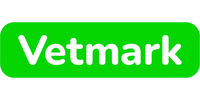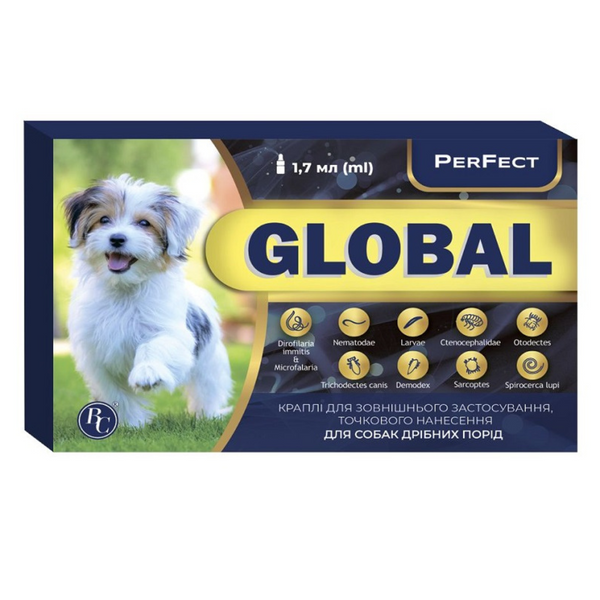|
Quantity
|
Out of stock
|
||
|
|
|||
Composition
1 ml of the drug contains the active ingredient: imidacloprid - 100.0 mg; moxidectin - 25 mg. Excipients: benzyl alcohol, propylene carbonate, butylhydroxytoluene (E 321).
Pharmacological properties
ATS vet: QP53A, ectoparasitic veterinary drugs for local use (QP53AX17 - imidacloprid, QP54AB02 - moxidectin).
PerFect GLOBAL for dogs is an endo- and ectoparasiticide for local use.The pharmacological properties of the drug are determined by the properties of the active substances: imidacloprid and moxidectin.
Imidacloprid is an ectoparasiticide that belongs to the class of nitromethylene heterocyclic compounds. The group of chemical composition of insectoacaricides is neonicotinoids. Imidacloprid has a high affinity for nicotinic acetylcholine receptors in the postsynaptic areas of the central nervous system (CNS). It interacts with the nicotinergic receptor of the ectoparasite located on the postsynaptic neuron, disrupts the transmission of a nerve impulse along it, and leads to paralysis and death of the ectoparasite. Due to the weak interaction with the nicotinic receptors of mammals and the low level of penetration through their blood-brain barrier, the active substance practically does not affect the central nervous system of mammals.
Moxidectin is a macrocyclic lactone of the second generation from the class of milbemycins, a semi-synthetic derivative of nemadectin, which is a fermentation product from the bacterium Streptomyces cyanogriseus (subspecies noncyanogenus). Moxidectin acts on many ecto- and endoparasites. It is active against nematodes of the alimentary canal and respiratory tract, as well as microdirofilaria (stages L3, L4) Dirofilaria spp. The mechanism of its action is due to the interaction with gamma-aminobutyric acid and glutaric chlorine tubules of parasites, which leads to the opening of chlorine tubules in the postsynaptic space and an increase in chlorine ions, as a result of which there is an irreversible decrease in muscle activity, paralysis and death of parasites. After applying the drug to the animal's skin, imidacloprid quickly spreads over the surface of the animal's skin within one day. Traces of imidacloprid remain on the skin throughout the treatment period.
The drug has a persistent effect and protects the animal after a single application for 4 weeks against re-infection with parasites.
Indications for use
Treatment and prevention of dogs with mixed parasitic infestations: Siphonapterosis: fleas (Ctenocephalides spp., Pulex irritans); Entomoses: hair eaters (Trichodectes canis), lice (Linognathus setosus); Acarosis: ear mite - otodectosis (Otodectes cynotis), dog scabies - sarcoptosis (Sarcoptes scabiei var. сanis), demodecosis (Demodex canis); Nematodes of the alimentary canal: toxocariasis (Toxocara canis - L4 larvae, adult and young forms), toxascarosis (Toxascaris leonine - L4 larvae, adult and young forms), hookworm (Ancylostoma caninum - adult and young forms), uncinariasis (Uncinaria stenocephala - adults and young forms), trichurosis (Trichuris vulpis - adult and young forms); Strongylatosis of the respiratory tract: crenosomosis (Crenosoma vulpis); Filariatosis: dirofilariasis (destruction of circulating microfilaria Dirofilaria spp. L3 and L4 larvae; Strongylatosis: angiostrongylosis (Angiostrongylus vasorum, including L4 and immature larvae); Spiruratosis: spirocercosis (Spirocerca lupi); The drug can be used as one of the means in the treatment of allergic fleas dermatitis (flea allergy dermatitis: FAD).
Contraindication
Increased individual sensitivity of the animal to the constituent components of the drug.
Do not use on sick, exhausted and weakened animals!
Do not use the drug for puppies under 7 weeks of age and weighing less than 1 kg.
Do not use the drug in pregnant or lactating females.
When treating otodectosis, do not inject the drug directly into the ear canal.
Do not apply the drug to wet or damaged animal skin.
Do not use the drug simultaneously with other insectoacaricides and macrocyclic lactones.
Side effect
After using the drug, dogs may experience short-term itching, redness of the skin, signs of greasy hair, and vomiting. These manifestations quickly pass without treatment.
Do not use the drug in pregnant or lactating females.
Do not use simultaneously with other drugs containing macrocyclic lactones.
Doses and methods of administration to animals of different ages
The drug is applied by dropwise (spot) application to dry, undamaged skin in a place inaccessible to animals for licking (between the shoulder blades). The minimum recommended dose for dogs is 0.1 ml per 1 kg of the animal's body weight (equivalent to imidacloprid - 10 mg/kg of body weight, moxidectin - 1.0 mg/kg of body weight). The minimum therapeutic interval is 4 weeks.
Before using the drug, it is recommended to weigh the animal and shake the contents of the bottle well. The cap of the bottle contains a pipette-dispenser. The contents of the pipette-dispenser are applied in drops according to the dosage.
1.7 ml bottle: 1.7 ml bottle is designed to treat animals weighing 17 kg. For animals of lower weight, the dose is calculated as follows: 1 drop of prepof arat from a pipette-dispenser (1 drop is equal to 0.03 ml) - per 300 g of the animal's body weight or 1 full press on the cap of the pipette-dispenser (contains 8 drops) - per 2.5 kg of the animal's body weight.
2.8 ml bottle: 2.8 ml bottle is designed to treat animals weighing 28 kg. For animals of smaller weight, the dose is calculated as follows: 1 drop of the drug from the pipette-doser - per 300 g of the animal's body weight or 1 full pressure on the cap of the pipette-doser and (contains 8 drops) - per 2.5 kg of the animal's body weight.
5.0 ml bottle: 5.0 ml bottle is designed to treat animals weighing 50 kg. For animals of smaller weight, the dose is calculated as follows: 1 drop of the drug from the pipette-doser - per 300 g of the animal's body weight or 1 full pressure on the cap of the pipette-doser (contains 8 drops) - per 2.5 kg of the animal's body weight.
The rest of the drug in the bottle can be used for the next treatment of the animal.
Treatment and prevention of flea infestation (Ctenocephalides spp., Pulex irritans).
A single application of the drug prevents future flea infestation for 4 weeks. It is advisable to combine the treatment of animals with the treatment of places where animals are kept and bedding in order to interrupt the life cycle of fleas in the environment.
In the combined treatment of flea allergic dermatitis, the drug is used monthly.
Treatment of damage by hair eaters (Trichodectes canis), damage by lice (Linognathus setosus).
The drug is applied once. A veterinary examination is recommended 30 days after using the drug, as in some cases re-treatment is necessary.
Treatment of ear scabies - otodectosis (Otodectes cynotis)
The drug is applied once. A veterinary examination is recommended 30 days after using the drug, as in some cases re-treatment is necessary. Do not apply directly into the ear canal.
Treatment of dog scabies - sarcoptosis (Sarcoptes scabiei var. canis).
The drug is applied twice, 1 dose with an interval of 4 weeks.
Treatment of demodecosis (Demodex canis).
Treatment with the drug is carried out every 4 weeks for 2-4 months, which leads to a noticeable improvement in the condition of the animal, in cases of mild and moderate severity. Particularly severe cases may require longer treatment, namely: the drug is used 2-4 times with an interval of 1 time per week. In all cases, treatment is continued until the results of 2 consecutive monthly laboratory tests are negative (skin scrapings). In cases where the animal does not improve after treatment with the drug for 2 months, the use of the drug is stopped and an alternative treatment is prescribed on the recommendation of a veterinarian.
Since demodicosis in dogs is often complicated by pyoderma, dermatomycoses, it is necessary to carry out complex treatment aimed at normalizing skin function, hormonal status, improving hair growth, strengthening immune reactions.
Treatment of damage by round helminths (nematodes) of the alimentary canal: toxocarosis (Toxocara canis), toxascarosis (Toxascaris leonina), hookworm (Ancylostoma caninum), uncinariasis (Uncinaria stenocephala), trichurosis (Trichuris vulpis).
The drug is used monthly.

































